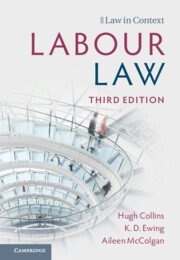Refine search
Actions for selected content:
112 results
CONTRACTUAL TRANSFERS OF TITLE
-
- Journal:
- The Cambridge Law Journal , First View
- Published online by Cambridge University Press:
- 07 November 2025, pp. 1-19
-
- Article
-
- You have access
- Open access
- HTML
- Export citation
The Current Status of the Contractual Choice of Law Clause Provisions in the Draft Restatement (Third) of Conflict of Laws
-
- Journal:
- German Law Journal / Volume 26 / Issue 5 / June 2025
- Published online by Cambridge University Press:
- 05 November 2025, pp. 815-828
-
- Article
-
- You have access
- Open access
- HTML
- Export citation
Chapter 4 - The Dialectic of Personal Freedom
- from Part II - Hegel Beyond Liberalism
-
- Book:
- Hegel Beyond Liberalism
- Published online:
- 27 September 2025
- Print publication:
- 16 October 2025, pp 89-129
-
- Chapter
- Export citation

Labour Law
-
- Published online:
- 02 October 2025
- Print publication:
- 20 November 2025
-
- Textbook
- Export citation
Chapter 18 - Financial services
-
- Book:
- Contemporary Australian Corporate Law
- Published online:
- 11 September 2025
- Print publication:
- 25 September 2025, pp 631-654
-
- Chapter
- Export citation
12 - The Conceptual Foundations of Contract Formation
- from Part III - Reinach and Legal Concepts
-
-
- Book:
- Reinach and the Foundations of Private Law
- Published online:
- 20 July 2025
- Print publication:
- 07 August 2025, pp 305-328
-
- Chapter
-
- You have access
- Open access
- HTML
- Export citation
8 - Servitude and Habitation Right
-
- Book:
- Property Law in China
- Published online:
- 09 July 2025
- Print publication:
- 24 July 2025, pp 223-242
-
- Chapter
- Export citation
4 - Contracts, Inequality, and the State
-
-
- Book:
- Legal Heterodoxy in the Global South
- Published online:
- 19 June 2025
- Print publication:
- 03 July 2025, pp 112-148
-
- Chapter
-
- You have access
- Open access
- HTML
- Export citation
Contracts, Treaties and Relationships: Collective Debt, Collective Responsibility and Contractarian Confusions
-
- Journal:
- Canadian Journal of Political Science/Revue canadienne de science politique / Volume 58 / Issue 2 / June 2025
- Published online by Cambridge University Press:
- 09 June 2025, pp. 319-338
-
- Article
- Export citation
14 - Using Experiments to Inform the Regulation of Consumer Contracts
- from Part II - Introductions
-
-
- Book:
- The Cambridge Handbook of Experimental Jurisprudence
- Published online:
- 17 May 2025
- Print publication:
- 05 June 2025, pp 217-238
-
- Chapter
- Export citation
14 - The Legal Situation Regarding Assisted Reproduction in Iran
-
-
- Book:
- The Rule of Law in the Islamic Republic of Iran
- Published online:
- 10 April 2025
- Print publication:
- 17 April 2025, pp 414-443
-
- Chapter
- Export citation
5 - Data Transparency, ERISA Preemption, and Freedom of Contract
- from Part II - Tools of Private Law
-
-
- Book:
- Health Law as Private Law
- Published online:
- 16 March 2025
- Print publication:
- 27 March 2025, pp 61-72
-
- Chapter
-
- You have access
- Open access
- HTML
- Export citation
15 - Paying for Health Care and Private Law’s Internal Point of View
- from Part IV - How Private law Can and Cannot Control Costs
-
-
- Book:
- Health Law as Private Law
- Published online:
- 16 March 2025
- Print publication:
- 27 March 2025, pp 192-203
-
- Chapter
-
- You have access
- Open access
- HTML
- Export citation
9 - Popes and Sexuality within and outside Marriage
- from Part II - Women, Gender, Sexuality
-
-
- Book:
- The Cambridge History of the Papacy
- Published online:
- 28 February 2025
- Print publication:
- 20 March 2025, pp 275-301
-
- Chapter
- Export citation
Perspectives on the sustainment of a healthy vending initiative in a university setting: a reflexive thematic analysis
-
- Journal:
- Journal of Nutritional Science / Volume 14 / 2025
- Published online by Cambridge University Press:
- 05 March 2025, e23
-
- Article
-
- You have access
- Open access
- HTML
- Export citation
3 - Intermediated Credit: Notarial Contracts
-
- Book:
- Before Banks
- Published online:
- 27 June 2025
- Print publication:
- 23 January 2025, pp 109-146
-
- Chapter
- Export citation
4 - The British People
-
- Book:
- Brexitspeak
- Published online:
- 22 November 2024
- Print publication:
- 05 December 2024, pp 85-102
-
- Chapter
- Export citation
A call for clarity in contractual accessions to shareholder and partnership agreements
-
- Journal:
- Legal Studies / Volume 45 / Issue 1 / March 2025
- Published online by Cambridge University Press:
- 20 November 2024, pp. 96-112
- Print publication:
- March 2025
-
- Article
-
- You have access
- Open access
- HTML
- Export citation
13 - Reasonable fee awards
- from Part 4 - Remedies as vindication
-
- Book:
- Remedies in Australian Private Law
- Published online:
- 25 October 2024
- Print publication:
- 12 November 2024, pp 384-399
-
- Chapter
- Export citation
18 - Personal remedies for unjust enrichment
- from Part 6 - Restitution and giving back
-
- Book:
- Remedies in Australian Private Law
- Published online:
- 25 October 2024
- Print publication:
- 12 November 2024, pp 490-503
-
- Chapter
- Export citation
